KIA SEDONA 2020 Owners Manual
Manufacturer: KIA, Model Year: 2020, Model line: SEDONA, Model: KIA SEDONA 2020Pages: 604, PDF Size: 16.24 MB
Page 581 of 604
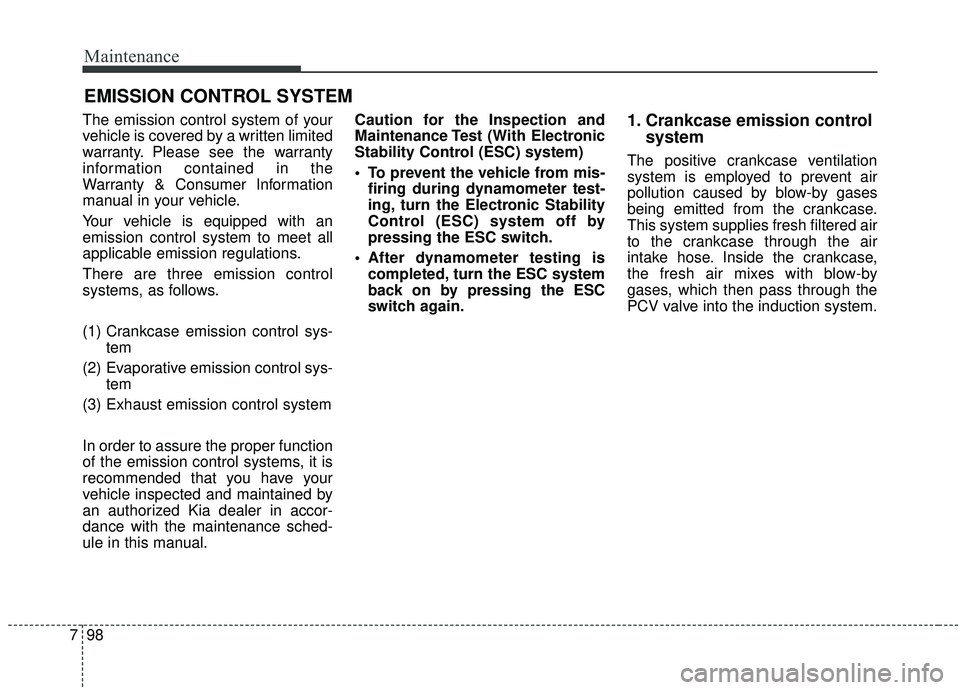
Maintenance
98
7
EMISSION CONTROL SYSTEM
The emission control system of your
vehicle is covered by a written limited
warranty. Please see the warranty
information contained in the
Warranty & Consumer lnformation
manual in your vehicle.
Your vehicle is equipped with an
emission control system to meet all
applicable emission regulations.
There are three emission control
systems, as follows.
(1) Crankcase emission control sys-
tem
(2) Evaporative emission control sys- tem
(3) Exhaust emission control system
In order to assure the proper function
of the emission control systems, it is
recommended that you have your
vehicle inspected and maintained by
an authorized Kia dealer in accor-
dance with the maintenance sched-
ule in this manual. Caution for the Inspection and
Maintenance Test (With Electronic
Stability Control (ESC) system)
To prevent the vehicle from mis-
firing during dynamometer test-
ing, turn the Electronic Stability
Control (ESC) system off by
pressing the ESC switch.
After dynamometer testing is completed, turn the ESC system
back on by pressing the ESC
switch again.1. Crankcase emission control system
The positive crankcase ventilation
system is employed to prevent air
pollution caused by blow-by gases
being emitted from the crankcase.
This system supplies fresh filtered air
to the crankcase through the air
intake hose. Inside the crankcase,
the fresh air mixes with blow-by
gases, which then pass through the
PCV valve into the induction system.
Page 582 of 604
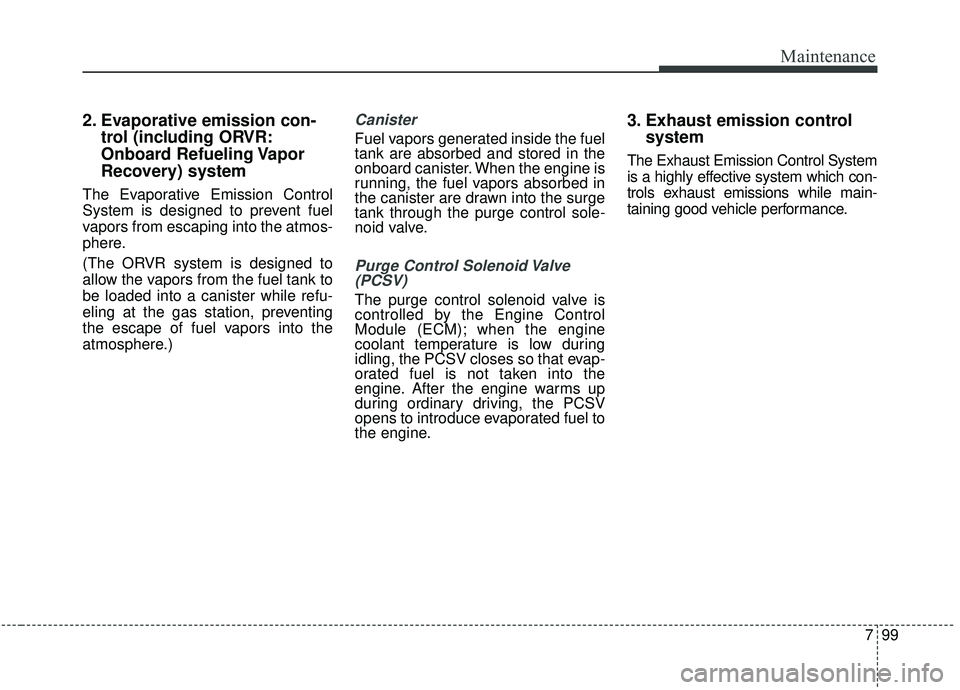
799
Maintenance
2. Evaporative emission con-trol (including ORVR:
Onboard Refueling Vapor
Recovery) system
The Evaporative Emission Control
System is designed to prevent fuel
vapors from escaping into the atmos-
phere.
(The ORVR system is designed to
allow the vapors from the fuel tank to
be loaded into a canister while refu-
eling at the gas station, preventing
the escape of fuel vapors into the
atmosphere.)
Canister
Fuel vapors generated inside the fuel
tank are absorbed and stored in the
onboard canister. When the engine is
running, the fuel vapors absorbed in
the canister are drawn into the surge
tank through the purge control sole-
noid valve.
Purge Control Solenoid Valve(PCSV)
The purge control solenoid valve is
controlled by the Engine Control
Module (ECM); when the engine
coolant temperature is low during
idling, the PCSV closes so that evap-
orated fuel is not taken into the
engine. After the engine warms up
during ordinary driving, the PCSV
opens to introduce evaporated fuel to
the engine.
3. Exhaust emission control
system
The Exhaust Emission Control System
is a highly effective system which con-
trols exhaust emissions while main-
taining good vehicle performance.
Page 583 of 604
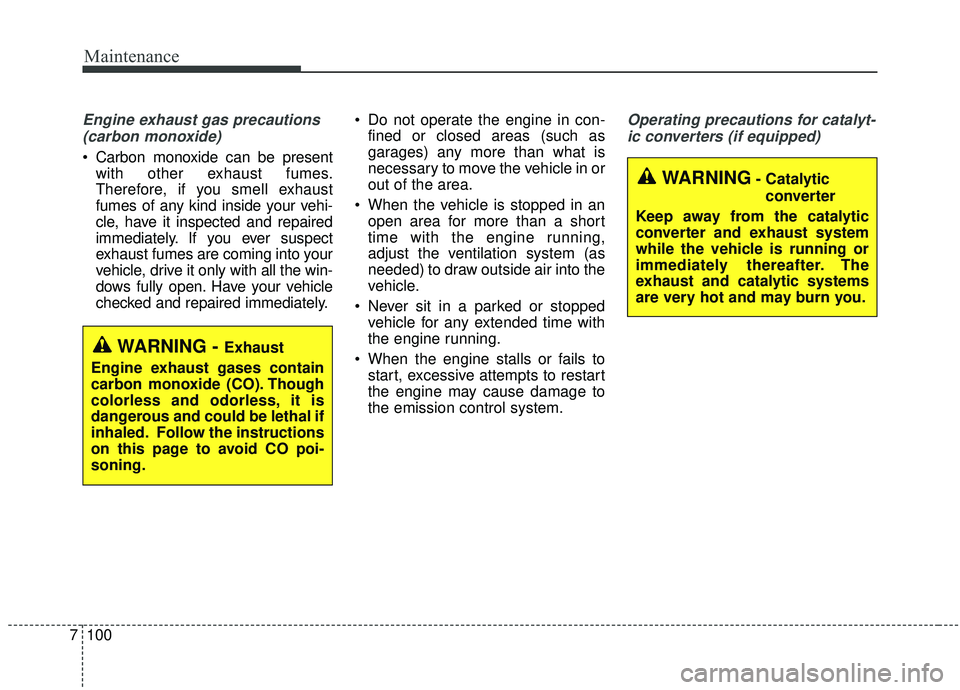
Maintenance
100
7
Engine exhaust gas precautions
(carbon monoxide)
Carbon monoxide can be present with other exhaust fumes.
Therefore, if you smell exhaust
fumes of any kind inside your vehi-
cle, have it inspected and repaired
immediately. If you ever suspect
exhaust fumes are coming into your
vehicle, drive it only with all the win-
dows fully open. Have your vehicle
checked and repaired immediately. Do not operate the engine in con-
fined or closed areas (such as
garages) any more than what is
necessary to move the vehicle in or
out of the area.
When the vehicle is stopped in an open area for more than a short
time with the engine running,
adjust the ventilation system (as
needed) to draw outside air into the
vehicle.
Never sit in a parked or stopped vehicle for any extended time with
the engine running.
When the engine stalls or fails to start, excessive attempts to restart
the engine may cause damage to
the emission control system.
Operating precautions for catalyt-
ic converters (if equipped)
WARNING - Exhaust
Engine exhaust gases contain
carbon monoxide (CO). Though
colorless and odorless, it is
dangerous and could be lethal if
inhaled. Follow the instructions
on this page to avoid CO poi-
soning.
WARNING- Catalytic converter
Keep away from the catalytic
converter and exhaust system
while the vehicle is running or
immediately thereafter. The
exhaust and catalytic systems
are very hot and may burn you.
Page 584 of 604
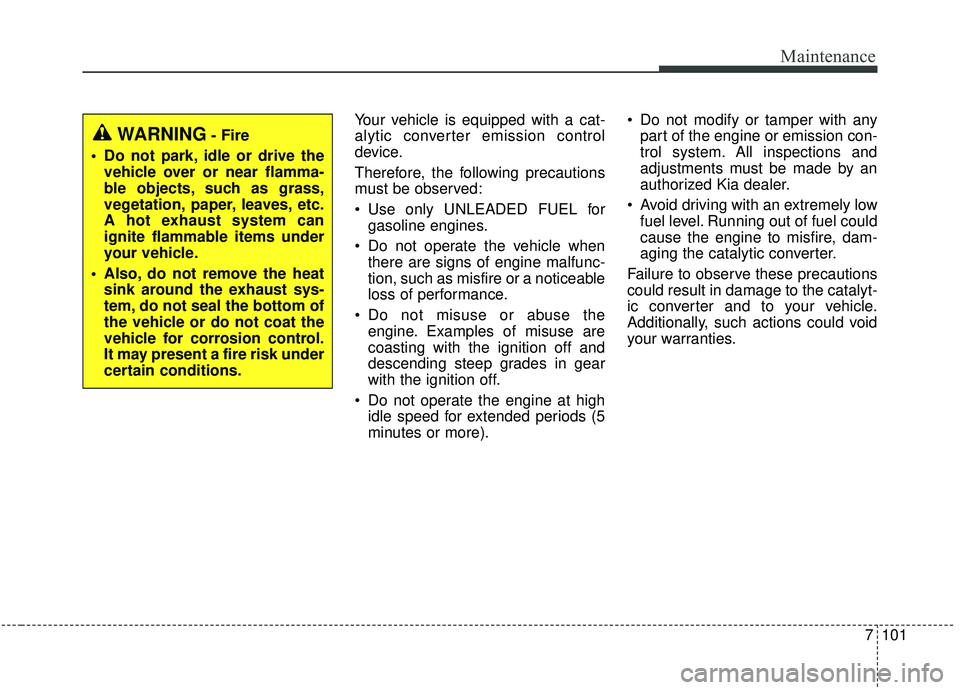
7101
Maintenance
Your vehicle is equipped with a cat-
alytic converter emission control
device.
Therefore, the following precautions
must be observed:
Use only UNLEADED FUEL forgasoline engines.
Do not operate the vehicle when there are signs of engine malfunc-
tion, such as misfire or a noticeable
loss of performance.
Do not misuse or abuse the engine. Examples of misuse are
coasting with the ignition off and
descending steep grades in gear
with the ignition off.
Do not operate the engine at high idle speed for extended periods (5
minutes or more). Do not modify or tamper with any
part of the engine or emission con-
trol system. All inspections and
adjustments must be made by an
authorized Kia dealer.
Avoid driving with an extremely low fuel level. Running out of fuel could
cause the engine to misfire, dam-
aging the catalytic converter.
Failure to observe these precautions
could result in damage to the catalyt-
ic converter and to your vehicle.
Additionally, such actions could void
your warranties.
WARNING- Fire
Do not park, idle or drive the vehicle over or near flamma-
ble objects, such as grass,
vegetation, paper, leaves, etc.
A hot exhaust system can
ignite flammable items under
your vehicle.
Also, do not remove the heat sink around the exhaust sys-
tem, do not seal the bottom of
the vehicle or do not coat the
vehicle for corrosion control.
It may present a fire risk under
certain conditions.
Page 585 of 604
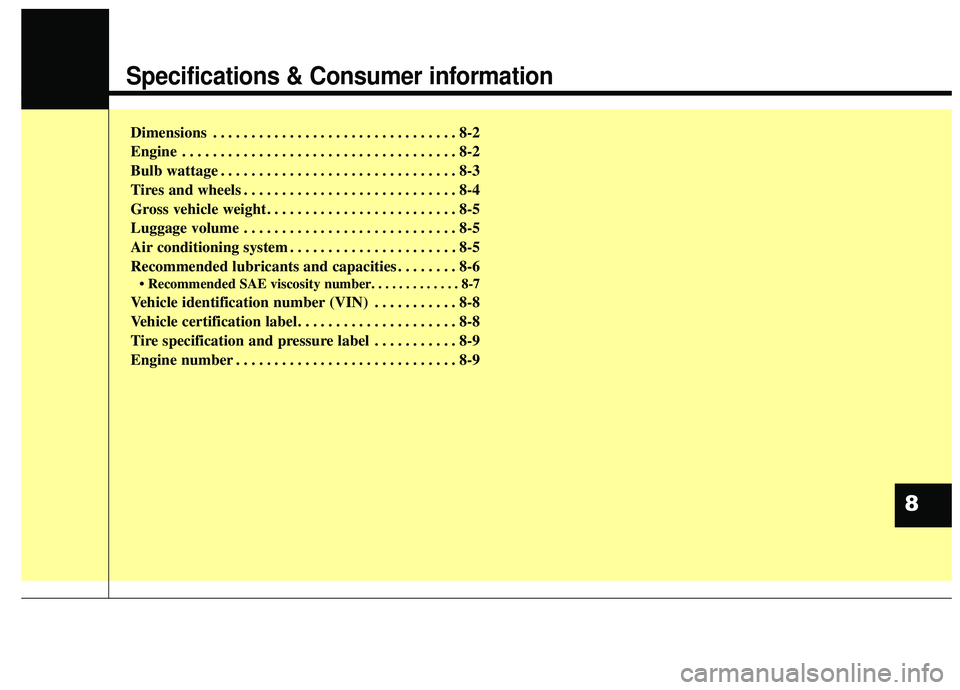
Specifications & Consumer information
Dimensions . . . . . . . . . . . . . . . . . . . . . . . . . . . . . . . . 8-2
Engine . . . . . . . . . . . . . . . . . . . . . . . . . . . . . . . . . . . . \
8-2
Bulb wattage . . . . . . . . . . . . . . . . . . . . . . . . . . . . . . . 8-3
Tires and wheels . . . . . . . . . . . . . . . . . . . . . . . . . . . . 8-4
Gross vehicle weight. . . . . . . . . . . . . . . . . . . . . . . . . 8-5
Luggage volume . . . . . . . . . . . . . . . . . . . . . . . . . . . . 8-5
Air conditioning system . . . . . . . . . . . . . . . . . . . . . . 8-5
Recommended lubricants and capacities . . . . . . . . 8-6
• Recommended SAE viscosity number. . . . . . . . . . . . . 8-7
Vehicle identification number (VIN) . . . . . . . . . . . 8-8
Vehicle certification label. . . . . . . . . . . . . . . . . . . . . 8-8
Tire specification and pressure label . . . . . . . . . . . 8-9
Engine number . . . . . . . . . . . . . . . . . . . . . . . . . . . . . 8-9
8
Page 586 of 604
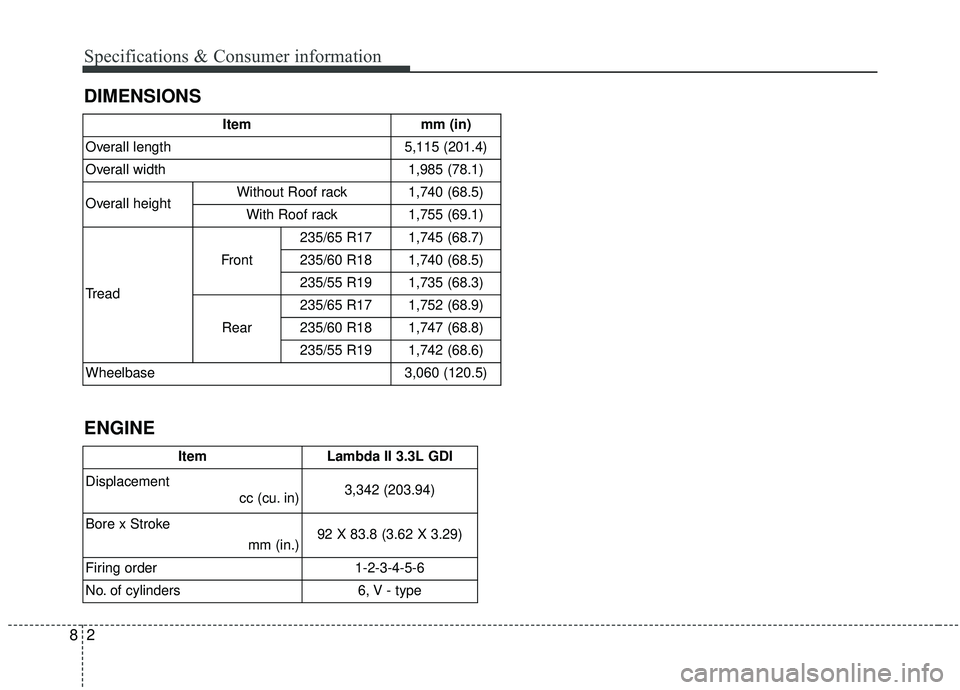
28
DIMENSIONS Specifications & Consumer information
Itemmm (in)
Overall length
5,115 (201.4)
Overall width
1,985 (78.1)
Overall height
Without Roof rack1,740 (68.5)
With Roof rack1,755 (69.1)
Tread
Front
235/65 R171,745 (68.7)
235/60 R181,740 (68.5)
235/55 R191,735 (68.3)
Rear
235/65 R171,752 (68.9)
235/60 R181,747 (68.8)
235/55 R191,742 (68.6)
Wheelbase
3,060 (120.5)
Item Lambda II 3.3L GDI
Displacement cc (cu. in) 3,342 (203.94)
Bore x Stroke mm (in.)92 X 83.8 (3.62 X 3.29)
Firing order 1-2-3-4-5-6
No. of cylinders 6, V - type
ENGINE
Page 587 of 604
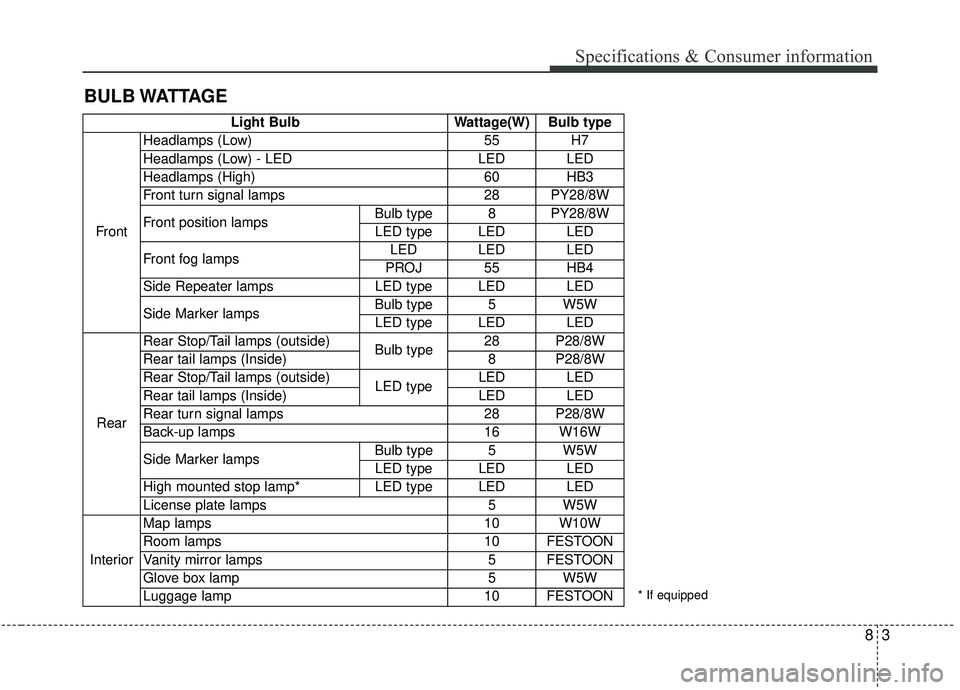
83
BULB WATTAGESpecifications & Consumer information
* If equipped
Light Bulb
Wattage(W) Bulb type
Front Headlamps (Low)
55H7
Headlamps (Low) - LED LED LED
Headlamps (High) 60 HB3
Front turn signal lamps 28 PY28/8W
Front position lamps Bulb type 8 PY28/8W
LED type LED LED
Front fog lamps LED LED LED
PROJ 55 HB4
Side Repeater lamps LED type LED LED
Side Marker lamps Bulb type 5 W5W
LED type LED LED
Rear Rear Stop/Tail lamps (outside)
Bulb type28 P28/8W
Rear tail lamps (Inside) 8 P28/8W
Rear Stop/Tail lamps (outside) LED typeLED LED
Rear tail lamps (Inside) LED LED
Rear turn signal lamps 28 P28/8W
Back-up lamps 16 W16W
Side Marker lamps Bulb type 5 W5W
LED type LED LED
High mounted stop lamp* LED type LED LED
License plate lamps 5 W5W
Interior Map lamps
10 W10W
Room lamps 10 FESTOON
Vanity mirror lamps 5 FESTOON
Glove box lamp 5 W5W
Luggage lamp 10 FESTOON
Page 588 of 604
![KIA SEDONA 2020 Owners Manual 48
TIRES AND WHEELS Specifications & Consumer information
ItemTire size Wheel sizee Inflation pressure [kPa (psi)]
Wheel lug nut torque
Normal load *1Maximum load
Front Rear Front Rear
Full size ti KIA SEDONA 2020 Owners Manual 48
TIRES AND WHEELS Specifications & Consumer information
ItemTire size Wheel sizee Inflation pressure [kPa (psi)]
Wheel lug nut torque
Normal load *1Maximum load
Front Rear Front Rear
Full size ti](/img/2/40439/w960_40439-587.png)
48
TIRES AND WHEELS Specifications & Consumer information
ItemTire size Wheel sizee Inflation pressure [kPa (psi)]
Wheel lug nut torque
Normal load *1Maximum load
Front Rear Front Rear
Full size tire 235/65 R17 6.5J X 17 240 (35) 240 (35) 240 (35) 240 (35)
11 ~ 13
(79 ~ 94, 107 ~ 127)
235/60 R18 7.0J X 18 240 (35) 240 (35) 240 (35) 240 (35)
235/55 R19 7.5J X 19 240 (35) 240 (35) 240 (35) 240 (35)
Compact spare tire T135/90 R17 4.0T X 17 420 (60) 420 (60) 420 (60) 420 (60)
CAUTION
When replacing tires, use the same size originally supplied with the vehicle. Using tires of a different size can damage the related parts or make it work irregularly.
*1 : Normal load : Up to 3 persons
✽ ✽ NOTICE
• It is permissible to add 21 kPa (3 psi) to the standard tire pressure specification if colder temperatures are expect-
ed soon.
Tires typically loose 7 kPa (1 psi) for every -11°C (12°F) temperature drop. If extreme temperature variations are
expected, re-check your tire pressure as necessary to keep them properly inflated.
• We recommend that when replacing tires, use the same originally supplied with the vehicles. If not, that aff\
ects driving performance.
• When driving in high altitude grades, it is natural for the atmospheric pressure to decrease. Therefore, please check the tire pressure and add more air when necessary.
Additionally required tire air pressure per km above sea level: 10.5 kPa (1.5 psi)
Page 589 of 604
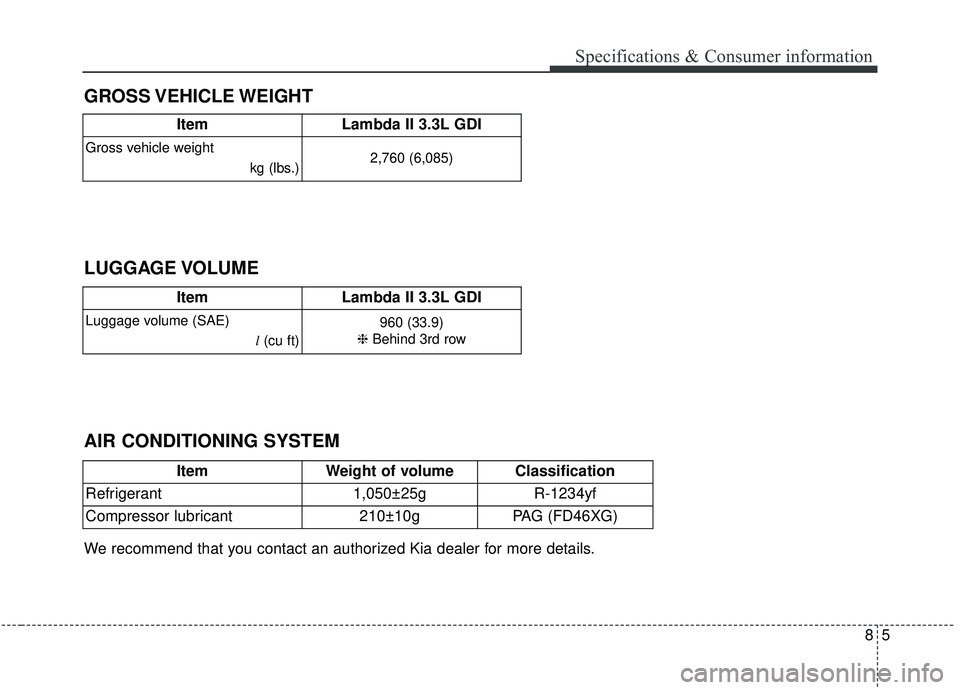
85
GROSS VEHICLE WEIGHTSpecifications & Consumer information
Item
Lambda II 3.3L GDI
Gross vehicle weight
kg (lbs.)2,760 (6,085)
AIR CONDITIONING SYSTEM LUGGAGE VOLUME
ItemWeight of volume Classification
Refrigerant
1,050±25g R-1234yf
Compressor lubricant
210±10g PAG (FD46XG)
We recommend that you contact an authorized Kia dealer for more details.Item Lambda II 3.3L GDI
Luggage volume (SAE)
l(cu ft) 960 (33.9)
❈ Behind 3rd row
Page 590 of 604
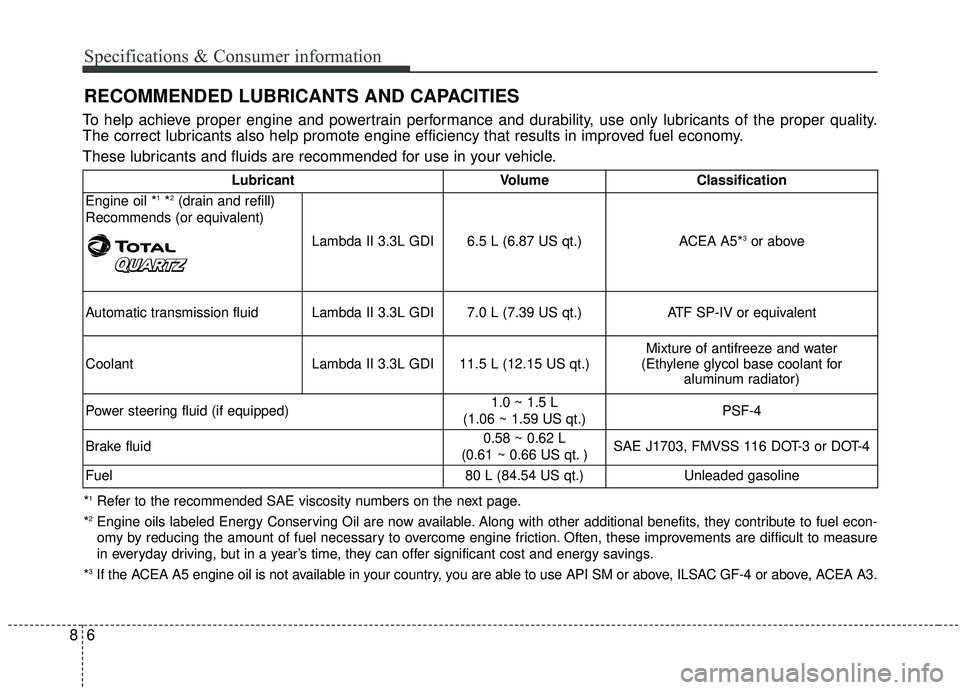
68
Specifications & Consumer information
RECOMMENDED LUBRICANTS AND CAPACITIES
To help achieve proper engine and powertrain performance and durability, use only lubricants of the proper quality.
The correct lubricants also help promote engine efficiency that results in improved fuel economy.
These lubricants and fluids are recommended for use in your vehicle.
*1Refer to the recommended SAE viscosity numbers on the next page.
*
2Engine oils labeled Energy Conserving Oil are now available. Along with other additional benefits, they contribute to fuel econ-
omy by reducing the amount of fuel necessary to overcome engine friction. Often, these improvements are difficult to measure
in everyday driving, but in a year’s time, they can offer significant cost and energy savings.
*
3If the ACEA A5 engine oil is not available in your country, you are able to use API SM or above, ILSAC GF-4 or above, ACEA A3. Lubricant Volume Classification
Engine oil *
1*2(drain and refill)
Recommends (or equivalent)
Lambda II 3.3L GDI 6.5 L (6.87 US qt.) ACEA A5*
3or above
Automatic transmission fluid Lambda II 3.3L GDI 7.0 L (7.39 US qt.) ATF SP-IV or equivalent
Coolant Lambda II 3.3L GDI 11.5 L (12.15 US qt.) Mixture of antifreeze and water
(Ethylene glycol base coolant for aluminum radiator)
Power steering fluid (if equipped) 1.0 ~ 1.5 L
(1.06 ~ 1.59 US qt.) PSF-4
Brake fluid 0.58 ~ 0.62 L
(0.61 ~ 0.66 US qt. ) SAE J1703, FMVSS 116 DOT-3 or DOT-4
Fuel 80 L (84.54 US qt.)Unleaded gasoline